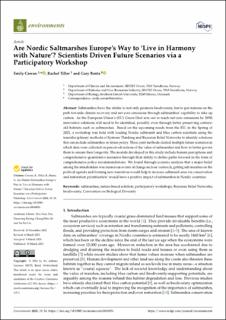| dc.contributor.author | Cowan, Emily Christine | |
| dc.contributor.author | Tiller, Rachel Gjelsvik | |
| dc.contributor.author | Banta, Gary T. | |
| dc.date.accessioned | 2023-10-24T12:18:44Z | |
| dc.date.available | 2023-10-24T12:18:44Z | |
| dc.date.created | 2023-04-18T11:08:26Z | |
| dc.date.issued | 2023 | |
| dc.identifier.citation | Environments. 2023, 10(3), 54. | en_US |
| dc.identifier.issn | 2076-3298 | |
| dc.identifier.uri | https://hdl.handle.net/11250/3098428 | |
| dc.description.abstract | Saltmarshes have the ability to not only promote biodiversity, but to put nations on the path towards climate recovery and net-zero emissions through saltmarshes’ capability to take up carbon. As the European Union’s (EU) Green Deal sets out to reach net-zero emissions by 2050, innovative solutions will need to be identified, possibly even through better preserving century-old habitats such as saltmarshes. Based on the upcoming needs from the EU, in the Spring of 2021, a workshop was held with leading Nordic saltmarsh and blue carbon scientists using the transdisciplinary methods of Systems Thinking and Bayesian Belief Networks to identify solutions that can include saltmarshes in future policy. These joint methods elicited multiple future scenarios in which data were collected on perceived notions of the value of saltmarshes and how to better govern them to ensure their longevity. The models developed in this study include human perceptions and comprehensive quantitative scenarios through their ability to define paths forward in the form of comprehensive policy recommendations. We found through scenario analysis that a major belief among the stakeholders was numerous events of change such as ‘outreach, getting salt marshes on the political agenda and forming new narratives would help to increase saltmarsh area via conservation and restoration prioritization’ would have a positive impact of saltmarshes in Nordic countries. | en_US |
| dc.language.iso | eng | en_US |
| dc.publisher | MDPI | en_US |
| dc.rights | Navngivelse 4.0 Internasjonal | * |
| dc.rights.uri | http://creativecommons.org/licenses/by/4.0/deed.no | * |
| dc.title | Are Nordic Saltmarshes Europe’s Way to ‘Live in Harmony with Nature’? Scientists Driven Future Scenarios via a Participatory Workshop | en_US |
| dc.title.alternative | Are Nordic Saltmarshes Europe’s Way to ‘Live in Harmony with Nature’? Scientists Driven Future Scenarios via a Participatory Workshop | en_US |
| dc.type | Peer reviewed | en_US |
| dc.type | Journal article | en_US |
| dc.description.version | publishedVersion | en_US |
| dc.rights.holder | © 2023 by the authors. Published by MDPI. | en_US |
| dc.source.pagenumber | 12 | en_US |
| dc.source.volume | 10 | en_US |
| dc.source.journal | Environments | en_US |
| dc.source.issue | 3 | en_US |
| dc.identifier.doi | 10.3390/environments10030054 | |
| dc.identifier.cristin | 2141549 | |
| dc.relation.project | Norges forskningsråd: 321334 | en_US |
| dc.source.articlenumber | 54 | en_US |
| cristin.ispublished | true | |
| cristin.fulltext | original | |
| cristin.qualitycode | 1 | |

